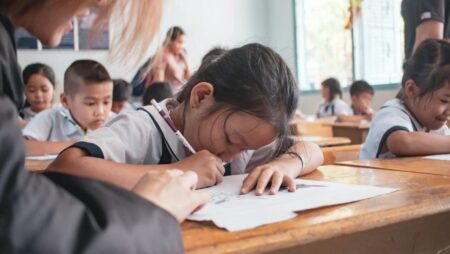On a given day, over 1 billion children around the world head to class. More children and adolescents today are enrolled in pre-primary, primary and secondary education than ever before. Yet, for many of them, schooling does not lead to learning, and this was before the schools were closed and disrupted learning across the globe, creating an urgent need to reimagine education.
Lack of infrastructure in schools:
A lack of well-trained teachers, inadequate learning materials, makeshift classes and poor sanitation facilities make learning difficult for many children. Others come to school too hungry, sick or exhausted from school or their household tasks to learn their lessons.
The consequences of this system of education are grave. An estimated 600 million children and adolescents worldwide are unable to reach minimum proficiency levels in reading and mathematics, and however, two-thirds of them are in school.
This learning crisis is the most significant global problem in preparing children and adolescents for life and active citizenship. Throughout the school, there are many non-learners in school than out of the school.
Moreover, 11 per cent of the children in the primary age and 20 per cent of the low secondary aged children are not at all in the schools. Children and adolescents are excluded from education for many reasons.
Poverty:
Poverty remains one of the most critical factors, and the children from the poorest households are almost five times more likely to be out of primary school than others. Children with disabilities and ethnic minorities are also more likely to be left behind.
Only 49 per cent of the countries have achieved gender parity in primary education. Harmful gender norms and policies can have severe effects on the boy children too. The location also keeps children from school.
Children from rural areas are more than twice as likely to be out of primary school than the children in urban areas. In the conflict zones, more than 3 million children are out of school. Without skills for lifelong learning, children face more significant barriers to earning potential and livelihood later in life.
They are more likely to suffer adverse health outcomes and less likely to participate in the incidents that affect them. They are dangered to build their schooling for themselves and their communities.
All the children have the right to go to school and learn, regardless of who these children are or how much money they have. Quality learning requires a sanitized environment. Qualified and motivated teachers are needed. The teachers are required to instruct the students in the language they understand.
It also requires that the learning outcomes are monitored, and feedback is given to the students. Digital classrooms and education should be made in schools.
Education crisis in schools:
In 150 countries around the world, learning opportunities for school students are provided. This prepares the children, and the adolescents will develop the knowledge and skills in the schools.
Gender equitable access to quality education from childhood to adolescence, including for the children with disabilities, marginalized children. The children are those who are living in humanitarian and emergency settings.
Quality learning and skill development outcomes in school come from solid education systems, and innovative solutions improve learning for the children in emergencies. The learning crisis is evident, and business, as usual, is not improving learning outcomes.
A more radical, new approach focuses on enhancing learning in school, which is longer and forms the basis. To create a world where every child learns, promoting equality is essential. This includes making targeted efforts for children who are excluded based on gender, disability, poverty, ethnicity, and language and those from the economically weaker section.













